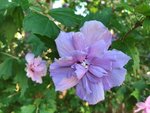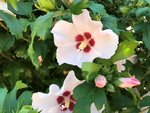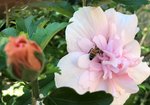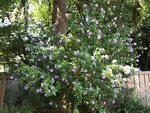




In today's context, "late bloomers" is not a reference to 40-year-old virgins, or to writers who publish their first novel at the age of 75.
Gardeners are more literal. When spring flowers are a distant memory, and summer flowers are fading fast, we're thinking about what comes next: the plants that start to bloom in late August and usher us into fall.
Hibiscus
Many think of hibiscus as a flower behind a Hawaiian hula dancer's ear, an exotic tropical blossom associated with a Hindu goddess, or the national flower of Haiti, Malaysia, and the Solomon Islands.
But many hardy species of hibiscus shrubs and small trees thrive here. The oldest and most familiar are often called the Rose of Sharon. That name applies to several varieties of large flowering shrubs that can be pruned to control their size.
Many are white or pink. The website Spruce lists another as "an example of a flower that pushes the violet hue in the direction of blue." That describes the one in my backyard, now almost old enough to drink and about 12 feet tall and almost as wide. It is newly covered in flowers and will be for another month.
I like it so much that I bought another hibiscus – a double-flowered pink one – four years ago. It was slow to get going; it followed the garden adage of "the first year it sleeps, the second year it creeps, the third year it leaps." This year it is blooming its heart out, to the delight of the bees who burrow deep into its double flowers.
A neighbor has the most common one: a zillion dramatic pale pink flowers with magenta centers and big, sexy reproductive parts.
Hibiscus is easy to grow and unfussy about soil and sun. Though they need water to get established, they're moderately drought tolerant once they get settled in.
Japanese anemones
Delicate pink or white flowers arise on tall stems, now so tall they seem to be looking in my dining room window. These flowers do best in soil that's not too rich, and they will thrive even in soil they share with a cedar tree, or on the north side of a building where they are in shade most of the time. If you make them too happy, they are likely to spread widely.
They've just started blooming, and their many tight, almost round buds will continue to open for the next six weeks. They are long-lasting as cut flowers, but shake them hard before you bring them in; the flowers are a favorite hangout of earwigs.
I was about to write that they are pest-free other than the earwigs, but then I looked out the window and saw a squirrel sitting on the fence eating their flower buds. Oh well, there are enough to share.
One other reason to grow them: It's fun to say "Japanese anemone." It's got rhythm! Someone should write a song about them, with their name in the refrain.
Seven Son Flower
Here's another name that's fun to say: Heptacodium miconioides, the Latin name for this small tree or large shrub from China.
A very persuasive nursery employee sold this small tree to me when I asked about Japanese maples. She was probably worried that it had been sitting in its pot too long and urgently needed a forever home. And she gave a great sales pitch: fragrant flowers, blooms in August and September, flowers followed by deep pink berry-like calyxes.
My little tree struggled for the first couple of years. It wanted a lot of water and leaned dangerously. It had to be staked to improve its posture. But don't all gardeners like a little life-or-death plant drama, especially if it ends well?
This year the not-so-little tree is doing fine and has just come into bloom. The flowers smell a little like jasmine, though the fragrance is not very strong. I was hoping passersby would like that, but it turns out bees and butterflies enjoy this tree even more, and the current issue of Fine Gardening hails it as a pollinator favorite.
A tree that flowers in August and September is a welcome sight, and so are all those happy bees.
P.S. Blackberries!
This is Peak Blackberry Week, and this is a peak blackberry year. A long rainy spring and a sunny hot summer have produced even more berries than usual, which is already a lot.
We tend to undervalue the common and the abundant, but we shouldn't. Blackberries are so good for trailside snacks, pies, cobblers, tarts, jam, jelly, ice cream . . . and here's my current favorite: blackberry homemade jello, made from blackberry juice, unflavored gelatin, and a little sugar. A summer treat that jiggles.
Jill Severn writes from her home in Olympia, where she grows vegetables, flowers and a small flock of chickens. She loves conversation among gardeners. Start one by emailing her at jill@theJOLTnews.com
1 comment on this item Please log in to comment by clicking here
Drutty
My hibiscus us ALWAYS late and even now no bloom yet~! But when it does it is huge and red~! The Japanese anemones are delightful now as they wave in a breeze above their bedmates.
Monday, August 29, 2022 Report this